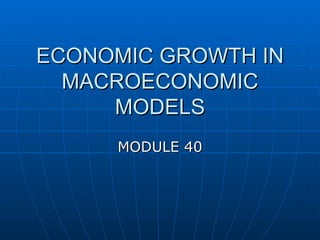
Module 40 economic growth in macroeconomic models
- 1. ECONOMIC GROWTH IN MACROECONOMIC MODELS MODULE 40
- 2. LONG-RUN ECONOMIC GROWTH Long-run economic growth is the sustained rise in the quantity of goods and services the economy produces as opposed to the short run-ups and downs of the business cycle. The fluctuations of actual output compared to potential output are the result of the business cycle.
- 3. LONG-RUN ECONOMIC GROWTH Long-run economic growth depends almost entirely on rising productivity. Good macroeconomic policy strives to foster increases in productivity, which in turn lead to long-run economic growth.
- 4. LONG-RUN ECONOMIC GROWTH AND THE PRODUCTION POSSIBILITIES CURVE The PPC is a graph that illustrates the trade-offs facing an economy that produces only two goods. Economic growth is shown as an outward shift of the PPC. In macroeconomics the PPC shows two different categories of goods: investment goods and consumer goods.
- 5. LONG-RUN ECONOMIC GROWTH AND THE PRODUCTION POSSIBILITIES CURVE The consumer goods include everything purchased for consumption by households. Investment goods include all forms of physical capital, which are goods used to produce other goods. The bowed out shape of the PPC reflects increasing opportunity costs.
- 6. LONG-RUN ECONOMIC GROWTH AND THE PRODUCTION POSSIBILITIES CURVE The PPC shows all possible combinations of consumer and investment goods that can be produced with full and efficient use of all the country’s resources. However, the PPC doesn’t tell us which of the possible points the country should select.
- 7. LONG-RUN ECONOMIC GROWTH AND THE PRODUCTION POSSIBILITIES CURVE Choosing to produce at a point on the PPC that creates more capital goods for the economy will result in greater production possibilities in the future (and thus greater economic growth).
- 8. LONG-RUN ECONOMIC GROWTH AND THE PRODUCTION POSSIBILITIES CURVE Over time, as an economy produces more goods and services, some of its capital is used up in that production. A loss in the value of physical capital due to wear, age, or obsolescence is called depreciation. Producing more consumer goods for the economy will result in a decrease in economic growth in the future.
- 9. LONG-RUN ECONOMIC GROWTH AND THE PRODUCTION POSSIBILITIES CURVE If an economy were to produce more consumer goods than capital goods year after year, it would find its stock of capital goods depreciating and its PPC curve would shift inward over time, indicating a decrease in production possibilities.
- 10. LONG-RUN ECONOMIC GROWTH AND THE PRODUCTION POSSIBILITIES CURVE The point where an economy chooses to produce depends on the values, politics, and other details related to the economy and people of the country. However, the choice made by the economy each year will affect the position of the PPC in the future.
- 11. LONG-RUN ECONOMIC GROWTH AND THE PRODUCTION POSSIBILITIES CURVE An emphasis on producing consumer goods will make consumers better off in the short run, but will prevent the PPC from moving farther out in the future. An emphasis on investment goods will lead the PPC to shift out farther in the future, but will decrease the quantity of consumer goods available in the short run.
- 12. LONG-RUN ECONOMIC GROWTH AND THE PRODUCTION POSSIBILITIES CURVE A country’s decision regarding investment in physical capital, human capital, and technology affects its long-run economic growth. Governments can promote long-run economic growth by investing in physical capital such as infrastructure, by promoting a well- functioning financial system, property rights, and political stability.
- 13. LONG-RUN ECONOMIC GROWTH AND THE AD-AS MODEL The long-run AS curve shows the quantity of aggregate output supplied when all prices, including nominal wages, are flexible. It is vertical at potential output because in the long run a change in the aggregate price level has no effect on the quantity of aggregate output supplied.
- 14. LONG-RUN ECONOMIC GROWTH AND THE AD-AS MODEL While actual GDP is almost always above or below potential output, reflecting the current phase of the business cycle, potential output is the level of output around which actual aggregate output fluctuates. A rise in potential output corresponds to a rightward shift of the LRAS curve.
- 15. LONG-RUN ECONOMIC GROWTH AND THE AD-AS MODEL The same government policies that promote an outward shift of the PPC promote a rightward shift of the LRAS curve.
- 16. DISTINGUISHING BETWEEN LONG-RUN GROWTH AND SHORT-RUN FLUCTUATIONS Both the PPC model and the AD-AS model can help us distinguish between long-run growth and short- run fluctuations due to the business cycle.
- 17. DISTINGUISHING BETWEEN LONG-RUN GROWTH AND SHORT-RUN FLUCTUATIONS The points along the PPC are achievable if there is efficient use of the economy’s resources. If the economy experiences a macroeconomic fluctuation due to the business cycle, production falls to a point inside the PPC. On the other hand, long-run growth will appear as an outward shift of the PPC curve.
- 18. DISTINGUISHING BETWEEN LONG-RUN GROWTH AND SHORT-RUN FLUCTUATIONS
- 19. DISTINGUISHING BETWEEN LONG-RUN GROWTH AND SHORT-RUN FLUCTUATIONS In the AD-AS model, fluctuations of actual aggregate output around potential output are indicated by shifts of AD or SRAS that result in short-run macroeconomic equilibrium above or below potential output. In this case, adjustments in nominal wages will eventually bring the equilibrium level of real GDP back to the potential level.
- 20. DISTINGUISHING BETWEEN LONG-RUN GROWTH AND SHORT-RUN FLUCTUATIONS Long-run economic growth is represented in the AD-AS model as a rightward shift of the LRAS curve. This corresponds to an increase in the economy’s level of potential output.
- 21. DISTINGUISHING BETWEEN LONG-RUN GROWTH AND SHORT-RUN FLUCTUATIONS
